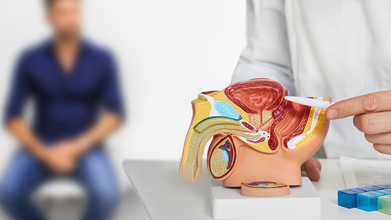- Health Conditions A-Z
- Health & Wellness
- Nutrition
- Fitness
- Health News
- Ayurveda
- Videos
- Medicine A-Z
- Parenting
- Web Stories
World Organ Transplant Day: From 3D Printing To Lab-Grown Organs, Transplant Breakthroughs Are Here

On World Organ Transplant Day, we usually hear about the urgent need for more donors, the lifesaving power of a transplant, and how one person’s decision can save up to eight lives. That is all still true and still critical but here is the twist: while the waiting lists grow, so do the technologies that might one day make them shorter or even unnecessary.
The future of organ transplantation is not just beating in donor hearts anymore; it is also whirring in lab incubators, spinning in magnetic rotors, and taking shape layer by layer on 3D bioprinters.
Despite decades of successful surgeries, the biggest roadblock in transplantation remains supply. Dr Bipin Chevale, CEO of Gleneagles Hospital Mumbai, explains, “There is still a persistent disparity between organ supply and demand. In India, thousands remain on waiting lists, and many lose their lives before a suitable organ becomes available.”
The reasons are a blend of low awareness, cultural taboos, and plain logistical hurdles. In 2023–24, nearly 50,000 Indians were waiting for organ replacement, according to the National Organ and Tissue Transplant Organisation (NOTTO). Globally, the US alone has more than 100,000 patients on transplant lists, with 13 lives lost every day while waiting.
Medical science, however, has been busy building backup plans. From 3D printing body parts to developing fully artificial organs, scientists are inching closer to a future where “no donor” does not mean “no hope”.
The Rise of 3D Bioprinting
Specialised 3D bioprinters can lay down living cells in precise patterns to create tissue that looks and behaves like the real thing.
Dr Varun Mittal, Head of Kidney Transplant at Artemis Hospitals, says researchers have “made great strides in printing living tissues and complicated networks of blood vessels”, something previously thought impossible. Techniques like Co-SWIFT create branching vessels inside heart tissue, while 3D ice printing uses water and gelatine to make smooth vessel templates.
While we are not yet popping out fully functional hearts or kidneys from printers for surgical use, these technologies are already valuable for training surgeons, testing drugs, and inching toward patient-specific implants. The idea is to design an organ to match a patient’s exact size, shape, and immune profile, dramatically lowering the risk of rejection.
Artificial Organs: Machines That Act Human
If printing an organ from scratch is the long game, artificial organs are the fast-forward button. These mechanical or bioengineered devices can take over the job of a failing organ, sometimes temporarily, sometimes for months or years.
One striking example is the BiVACOR artificial heart. It does not beat; it spins. A magnetic rotor pumps blood continuously, acting as a bridge until a donor heart is found. Dr Mittal points out that some patients have survived for months with the device, staying mobile and alert while awaiting surgery.
Similarly, researchers are developing implantable bioartificial kidneys that could filter blood and house living kidney cells without the need for dialysis or lifelong immunosuppressants. Wearable dialysis units are also in the works, aimed at freeing patients from hours tethered to clinic machines.
The Lung and Liver Challenge
Some of the boldest experiments are happening with lungs and livers, two of the trickiest organs to replace due to their complexity.
Dr Yasir Rizvi, Director of Nephrology and Kidney Transplant at Dharamshila Narayana Superspeciality Hospital, points to a landmark in lung research: a 3D-printed human-scale scaffold containing about 4,000 km of capillaries across 44 trillion voxels. In animal studies, it has already exchanged gases like a natural lung.
For the liver, bioprinting and bioengineering efforts aim to create functional tissue that can sustain patients until a full transplant is possible or even act as a permanent fix in the future.
The Benefits Are Already Here
We may still be a few years from printing a fully functional, transplant-ready heart, but artificial organ technology is already improving lives. Pacemakers, cochlear implants, and ventricular assist devices, these are all proof that machinery and biology can coexist in the human body.
Artificial organs have the potential to:
- Reduce rejection by using a patient’s own cells
- Cut waiting times dramatically
- Lower long-term medical costs by reducing hospital stays
- Give access to treatment in regions where donor organs are scarce
As Dr Chevale says, these breakthroughs are only half the story. “Their success will also depend on increasing awareness about organ donation, busting myths, and encouraging more people to pledge their organs.”
The Ethical Road Ahead
Of course, the march toward lab-grown and artificial organs comes with big ethical questions. Who gets them first? Will they be affordable or only for the wealthy? How do we ensure safety in devices meant to live inside fragile bodies?
Dr Rizvi believes that with “careful regulation, transparent trials and patient-centred design, these innovations can turn prototypes into standard care”. In India, collaborations between AIIMS, IITs, and bio-technical start-ups are already laying the groundwork, with the hope of producing affordable devices for both domestic and global use within a decade.
A Future Worth Donating To
Even if the day comes when a printer can make you a brand-new kidney, organ donation will still matter. Research organs, temporary implants, and hybrid solutions will always benefit from donated tissue to validate safety and function.
The future of transplantation is no longer just a race against the clock for a donor organ, it is also a race to develop, print, and perfect replacements that can save lives anywhere, anytime.
3 Fertility Truths Every Woman Should Know, According To A Gynecologists

(Credit-Canva)
Infertility impacts millions across the globe, touching both men and women alike. According to the World Health Organization, around 17.5% of the global population, roughly one in six people, experience fertility challenges. This condition can significantly reduce or even prevent natural conception.
Yet, despite its prevalence, infertility remains clouded by myths and misconceptions, many of which unfairly place the blame solely on women. Seeking to debunk these long-held beliefs, Dr. Holly Miller, an American Board-certified obstetrician and gynecologist, took to Instagram to share three important truths every woman should know about fertility.
3 Truths About Fertility Women Should Know
With the help of modern medicine and medical interventions like IVF, fertility treatment can help people boost their chances of reproducing.
Infertility Isn't Just a Woman's Issue
It’s important to understand that infertility affects both partners — it’s not solely a woman’s issue. Blaming only the woman is both unfair and inaccurate. In fact, experts find that the causes of infertility are almost evenly split between men and women.
Roughly one-third of infertility cases are linked to the woman, another third to the man, and the remaining third result from issues affecting both partners — or from causes that doctors are unable to clearly identify.
To identify the cause of infertility, both partners should undergo testing simultaneously. For men, a semen analysis — a quick and straightforward test — is often the easiest and most informative first step.
The "Wait One Year" Rule Changes with Age
Most couples automatically try to conceive for a full 12 months before they think about seeing a fertility doctor. However, the doctor emphasizes that the woman's age is the single most important factor that affects the chances of successful treatment.
If you are under 35 years old: You can safely try for a full 12 months of regular, unprotected sex before seeking a specialist.
If you are 35 or older: You should contact a specialist after only 6 months of trying without success.
If you are 40 or older: You need to see a specialist right away—as quickly as you possibly can.
The doctor explains that after age 35, the woman's egg supply starts to decline more quickly. Time is essential, so couples should strongly ask their doctors for an early referral.
"Unexplained Infertility" Often Means "Undiagnosed Problem"
When a couple is diagnosed with "unexplained infertility," which happens in about 10% to 20% of cases, it means the basic first tests did not find a clear reason. This can be upsetting, but it does not mean you can never have children. In the doctor's experience, the term "unexplained" often means there are hidden problems, such as:
- Small issues with the male partner's sperm that were missed by the basic tests.
- A hidden condition called Endometriosis, which can only be confirmed by a surgical procedure.
- Not having sexual intercourse at the best time or not often enough.
Hyderabad Neurologist Shares Case Of 25-Year-Old Software Engineer Diagnosed With ‘Tennis Elbow’ Caused by Computer Overuse

(Credit-Canva)
In today's corporate world, desk jobs have become the order of the day and so are the health problems associated with them. Endless typing, long hours of sitting, and poor posture are silently taking their toll on young professionals who spend most of their day glued to screens. Many don't realize that their daily work habits could trigger unexpected medical conditions.
Such a growing concern was once highlighted by Hyderabad-based neurologist Dr Sudhir Kumar, who recently shared a case on X. He wrote about one such case of Riya (name changed), a 25-year-old software engineer who developed a sharp, burning pain in her elbow-a pain which began as a minor ache while typing and gradually became so severe that even lifting a teacup felt unbearable.
What was the cause of the sharp elbow pain that Riya experienced?
Riya tried everything she could think of: Rest, pain relief balms, painkillers, even switching hands while using her computer, but the pain refused to fade. When she finally decided to visit the doctor, her symptoms immediately pointed to something unexpected: Tennis elbow. The diagnosis came as a surprise, considering she had never even held a tennis racket. On examination, Dr Sudhir Kumar found the tell-tale signs of the condition, medically known as lateral epicondylitis — tenderness along the outer elbow and pain when she tried to extend her wrist. He explained that the culprit wasn’t a sport, but repetitive strain from long hours at the computer — a problem increasingly common among desk workers.
What is Tennis Elbow?
The Mayo Clinic describes tennis elbow, medically termed lateral epicondylitis, as a painful condition resulting from the overuse of muscles and tendons in the forearm. It develops where these tissues are repeatedly strained by similar wrist and arm movements, leading to tiny tears and inflammation near the elbow.
The name is misleading, and you don't have to be an athlete to get tennis elbow. As a matter of fact, most people who develop it never have used a racket. It's common for the condition to strike people in jobs that require repetitive motions: plumbers, carpenters, painters, butchers, and yes, office workers who spend hours typing or using a mouse.
The pain generally arises on the outside of the elbow, precisely at that bony prominence to which the muscles of the forearm attach. For some, the discomfort may extend into the forearm or even the wrist, making most activities quite arduous.
How Can Tennis Elbow Be Treated?
Once the diagnosis was confirmed, Dr Sudhir Kumar focused on addressing the underlying cause — repetitive stress and poor workstation ergonomics. The holistic treatment for Riya included the following:
- Avoided repetitive activities that triggered her pain.
- Adjusting the computer setup and improving posture.
- Establish a physiotherapy regimen to stretch, strengthen, and gradually build muscle endurance.
- A short course of anti-inflammatory medication
Employing a counterforce brace-a tennis elbow strap-to reduce strain in daily activities. By her six-week follow-up, Riya’s pain had completely resolved. Her grip strength was back, and she could type, lift, and exercise without discomfort. Three months later, she was symptom-free — and far more aware of how small ergonomic changes can make a big difference.
80% Americans Do Not Know THIS Key Fact About Early Prostate Cancer Symptoms

(Credit-Canva)
Prostate cancer is one of the leading causes of cancer deaths, however, a recent survey showed that most people don’t know this vital fact about prostate cancer symptoms.
Prostate cancer is a serious illness in the US, affecting over 300,000 men each year and causing more than 35,000 deaths, according American Cancer Society. This makes it the second-most deadly cancer for men. If doctors detect the disease early, it is treatable. However, patients usually don't notice any signs of the disease in its beginning stages. Due to this lack of symptoms, checking for the disease is extremely important.
A recent survey of 1,004 U.S. adults, commissioned by the Ohio State University Comprehensive Cancer Center, aimed to gauge public knowledge of the disease. The findings highlight a critical need for better education.
What Do Americans Know About Early-Stage Prostate Cancer?
The results showed that most people, 80% of those surveyed, are unaware that early prostate cancer usually has no physical symptoms. One health specialist noted that it's crucial for everyone to understand that this cancer causes no symptoms until it has become advanced. The survey also revealed other gaps in knowledge:
- More than half of the people surveyed (59%) did not know that changes in sexual function could be a sign of prostate cancer.
- The survey noticed some differences across groups. For example, one minority group was better at identifying less common signs like tiredness and weight loss.
- However, that same minority group was less likely than others to correctly identify that the cancer usually has no symptoms in its early stage.
What Is The Best Way To Diagnose Prostate Cancer?
The fact that prostate cancer often begins without symptoms is the main reason doctors worry.
Lack of Symptoms
In its early phase, the cancer is small and contained within the prostate gland. It doesn't push on or block any other body parts, so it doesn't cause pain or discomfort. Because the cancer is deep inside the body, it's hard to tell if someone has it without special tests.
Provider Worry
Because men feel fine, they may wrongly believe they aren't at risk. This feeling of being safe often makes men hesitant to get screened. Since there are no symptoms to look for, screening tests, usually a simple blood test or a physical exam, are the best way to find the cancer early.
What Are Some Signs of Prostate Cancer?
Even though most men with early prostate cancer feel completely normal, there are certain signs that might appear if the disease is more advanced. These symptoms include:
- Having trouble starting to urinate.
- Having a urine flow that is weak or stops and starts.
- Needing to urinate often, especially during the night.
- Difficulty completely emptying the bladder.
- Feeling pain or a burning sensation while urinating.
- Noticing blood in the urine or semen.
- Feeling pain in the back, hips, or pelvis that doesn't go away.
- Experiencing pain during ejaculation.
When Should You Get Screened For Prostate Cancer?
According to American Cancer Society, health organizations advise men to talk with their doctors about getting checked for prostate cancer starting at certain ages, depending on their personal risk.
Average Risk: Age 50
Men who have no special risk factors.
High Risk: Age 45
Men who are African American or who have a father or brother who was diagnosed before age 65.
Highest Risk: Age 40
Men who have more than one close relative (father or brother) diagnosed at an early age. There is no one-size-fits-all advice for screening. Men should always speak to their doctor about their own risk and discuss the pros and cons of testing. Since there are no early warning signs, talking to a doctor about screening is described as "critical" and a simple process that could potentially save a man's life.
© 2024 Bennett, Coleman & Company Limited

